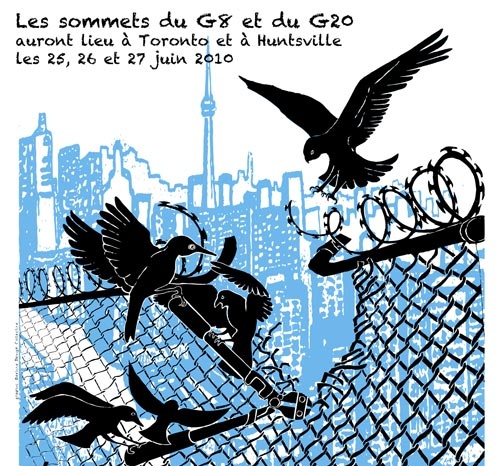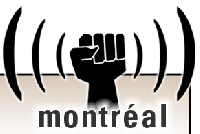 |
 |
 |
 |
 |
 |
|
 |
 |
 |
 |
 |
 |
 |
Régions du Québec |  |
 |
 |
|
 |
 |
|
 |
 |
|
 |
 |
 |
 |
 |
 |
Rubriques (sujets) |  |
 |
 |
|
 |
 |
|
 |
|
 |
 |
 |
Building a Community Based Resistance Movement from the Grassroots
A look at the need for any large movement(s) and actions to be solidly grounded in grassoots community organizing.....with the FTAA and the Quebec Summit as an example.
Building a Community Based Resistance Movement from the Grassroots
Ayal Dinner and Charles Levkoe
"What is difficult to convey in media reports is that there weren't two protests that took place in Quebec City -- one a "peaceful" labour march, the other a "violent" anarchist riot. There were hundreds of protests. One was organized by a mother and daughter from Montreal. Another by a vanload of grad students from Edmonton. Another by three friends from Toronto who aren't members of anything but their health clubs. Yet another by a couple of waiters from a local café on their lunch break." (Naomi Klein, from "The Bonding Properties of Tear Gas," Wednesday, April 25, 2001 in the Globe and Mail)
In a time when economic disparities continue to widen and ecological destruction is increasing, more people in the privileged ‘minority world’ are standing up against injustice. April 17th to the 21st 2001, witnessed a massive gathering of people from all facets of life and from all countries of the world coming together over a common concern. It was a clear statement that citizens of the world will not accept that power and profit take precedence over the rights of people and the environment.
These people included: teachers, students, activists, lawyers, politicians, business owners, environmentalists, spiritual leaders, community leaders, unionists, service workers, labourers, nationalists, artists, health care workers, indigenous peoples and many others. Political, economic and social backgrounds and opinions varied widely across the spectrum. As our mothers and fathers fought historic struggles, such as for the rights of women and workers, they instilled important values in us and we continue their vision.
It was a statement of free speech through creative, expressive, and intellectual outlets. There were puppets, street theater, teach-ins, placards, direct action, cheerleaders, academic and community lectures, networking, discussions and workshops, parades, public education, music, dancing, trainings and celebrations.
It was an event bringing together a citizen’s movement and it happened all over the world. Although it was directly focused on the Summit of the Americas meetings in Quebec City where over 60,000 individuals came together, solidarity events occurred in many cities around the globe. In Washington State and British Columbia the Peace Bridge was temporarily closed by activists on both sides of the border. In South and Central America thousands of people were involved in demonstrations from Mexico to Argentina. Across Canada major events were held in Vancouver, Edmonton, Calgary, Saskatoon, Winnipeg, Toronto, Waterloo, Guelph, Antigonish and in Charlottetown, to name only a few.
The large scale actions which we have seen most recently in Quebec City in April (also in the past few years in Vancouver, Seattle, Calgary, Washington, Windsor and Prague) raise some very important questions for activists and anyone concerned with a democratic, just and sustainable world community: Is there value in large scale actions as opposed to issue-specific, smaller, grassroots based action?
Questions such as this are what we as activists and responsible Canadians must ask ourselves and discuss on an ongoing basis. There are many critics who see resistors of anti-corporate globalization as a group of confused, misguided hooligans. Furthermore, many from within the movement have expressed their fears of large-scale gatherings becoming a sort of "McProtest" characterized by their similarity of an unorganized rash of violent activity with few goals or directions.
In a local community setting the advantage of resistance movements is that they are generally organic. In most cases they form from a community based need or issue of concern. Citizens often find a personal connection, become empowered and develop a drive to participate and get involved.
Large scale actions face the inherent challenge of finding a balance between being on one side, unorganized, exclusionary and unproductive and on the other, being overly controlled, hierarchical and dogmatic. The challenge is to find and maintain this balance while preserving the grassroots nature of organized resistance on a large-scale basis.
Preservation of the Grassroots
All resistance movements whether they are large or small scale must be deeply rooted in community and likewise must be accountable to those communities. As well, they must be inclusive through processes such as democratically based consensus decision making.
The ‘affinity group model’ used in recent large scale actions is one way that participants attempt to reach this balance. Through the use of local organization based on needs, issues, and trust the goal is to preserve the grassroots nature of resistance in large scale gatherings. Ideally there is much leadership but no leaders. There is strength in diversity. It is the attempt to bring together individuals and groups who share something in common into something larger. In this case the Quebec City meeting of the Free Trade Area of the Americas and resistance against prioritizing profits and power over people and the environment.
Although there were many alternative visions put forth and even an alternative agreement proposed (see http://www.web.net/comfront/alts4americas/eng/eng.html), the majority of the participants had no final goals nor any naive expectations that issues of human rights and the environment would be brought to the FTAA’s table. The events that we saw in Quebec City and in local communities in April are not the beginning of the movement, nor are they the end.
The 60,000 people who gathered in Quebec City and the billions who watched, marched and rallied in solidarity were part of a process, of building a better and stronger community. They participated in the democratic processes through trainings, meeting other activists, questioning, criticizing and resisting. To all of them, both the means and the ends are the goal.
It is a process of learning how to build and to move forward in a positive direction and to do it sustainably as a group. It is a process in un-learning, re-learning and a process of living.
Resistance
By using the affinity group model, it was clear that there is a way to be an individual yet to be a part of something larger and collective.
Something valuable we all learned is that there are many ways of resisting. Whether one is a vegetarian, an organic farmer, a critical thinker, an anarchist, a protester or even part of a ‘natural activist group’ (i.e. the poor, women or any minority group) we are all working together and have common interests and goals. Furthermore the greater goal is evident. We all aspire to develop an ongoing lifestyle of community building and positive living.
Corporate globalization affects and threatens us all. Through the recognition of this, each and every one of us can join in unity and organize locally in our own communities. Then when the next large-scale gathering occurs we will be there, or in solidarity in our local communities. Later this year from November 9-13 the World Trade Organization will be meeting again. In Doha, Qatar, trade ministers from 142 countries will meet to decide whether to launch a new round of trade negotiations. Since access to these meetings will be virtually impossible for most, solidarity actions will be more vital then ever.
Something else that we have learned is that we cannot afford to be reactive to the actions of corporations and power mongers such as the World Bank and World Trade Organization. We must be pro-active by constantly continuing to build alternative frameworks. Solidarity actions are one way, but it is important to develop international social forums and forums in local communities to discuss these issues. From there we can continue to put our visions and ideals into practice.
Both large and local actions are necessary and in many ways synonymous. If the movement is to be successful, there must be a mix of education in local communities and an understanding and connection to the large-scale actions. Communities must feel a sense of belonging and not that it is taking place ‘over there’. There must be diversity of visions, of actions, and of outcomes. Although an individual or a group can be arrested or subverted, a movement cannot be destroyed. When large-scale resistance movements remain grassroots they are thus indestructible.
Charles Levkoe organized solidarity actions for the in Edmonton, Alberta.
Ayal Dinner was a member of an affinity group in Quebec City and helped educate and organize in Kitchener-Waterloo, Ontario.
 |
 |
 |
 |
Dossier G20 |  |
 |
 |
|
 |
 |
|
 |
Nous vous offrons plusieurs reportages indépendants et témoignages...

Liste des activités lors de ce « contre-sommet » à Toronto Vous pouvez aussi visiter ces médias alternatifs anglophones... Centre des médias Alternatifs Toronto 2010.mediacoop.net Media Co-op Toronto http://toronto.mediacoop.ca Toronto Community Mobilization www.attacktheroots.net (en Anglais) |
 |
 |
 |
 |
 |
 |
 |
CMAQ: Vie associative |  |
 |
 |
|
 |
 |
|
 |
 Collectif à Québec: n'existe plus. Impliquez-vous ! |
 |
 |
 |
 |
 |
 |
 |
 |
|
 |
 |
 |
Ceci est un média alternatif de publication ouverte. Le collectif CMAQ, qui gère la validation des contributions sur le Indymedia-Québec, n'endosse aucunement les propos et ne juge pas de la véracité des informations. Ce sont les commentaires des Internautes, comme vous, qui servent à évaluer la qualité de l'information. Nous avons néanmoins une
Politique éditoriale
, qui essentiellement demande que les contributions portent sur une question d'émancipation et ne proviennent pas de médias commerciaux.
This is an alternative media using open publishing. The CMAQ collective, who validates the posts submitted on the Indymedia-Quebec, does not endorse in any way the opinions and statements and does not judge if the information is correct or true. The quality of the information is evaluated by the comments from Internet surfers, like yourself. We nonetheless have an
Editorial Policy
, which essentially requires that posts be related to questions of emancipation and does not come from a commercial media.


